Cowries in Sudan; Divination and Adornment
Part 1 Reading the Shells – Divination
Setting the Scene
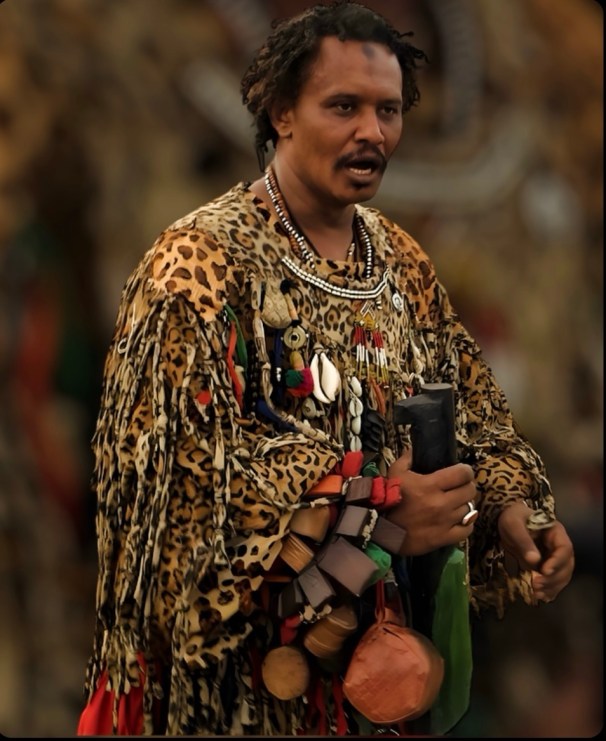
Above, strands of cowrie shells, beads and finely worked leather hijabs (talismans enclosing sacred script) worn by a Sufi mystic at the Friday evening dhikr / zikr ceremonies, Hamid Al-Nil, Omdurman. See A Thousand Prayers, Unfolding Blessings and The Eternal Dance for more on Sudanese Sufism.
Cultures across the world have invested cowries with talismanic properties. They enhance religious, spiritual and ancestral ritual, adorn hair, headdresses and garments of wealthy and poor alike. They have functioned as currency, been crafted into fine jewelry, and have embellished musical instruments. They have been also been shaped and strung to make music in their own right.
See more in The Sudanese Tambour

Above, the lyrics of the very popular ballad, “Sitt al-Wada'”. An anxious suitor seeks reassurance in vain from a Sitt al-wada’ or fortune-teller skilled in the art of divination using cowrie shells. An annotated transcript of the song will be available shortly on Sudanese Arabic Documentary Transcripts. I close this article with a summary of the ballad below. My thanks to Muna Zaki for her invaluable guidance in interpreting the lyrics.
Enjoy the song here: ست الودع – اغاني .
The ancient practice of cowrie shell divination excites approbrium and affection in equal measure throughout Sudan where it stubbornly endures in contemporary Sudanese culture, inspiring numerous songs, verses and comedic sketches, as in the inimitable سِت الودِع | بطولة النجم عبد الله عبد السلام (فضيل) | تمثيل مجموعة فضيل الكوميدية ,

Above, stills from the opening scenes of سِت الودِع | بطولة النجم عبد الله عبد السلام (فضيل) | تمثيل مجموعة فضيل الكوميدية , Often conducted at home over coffee and accompanied by incense, khaTT al-widi’ / wada’ or divination by throwing cowrie shells can be both therapeutic and entertaining in turbulent times. The fortune teller throws seven cowrie shells – seven for the days of the week – onto a prepared, even, sandy surface and seeks to resolve the personal dilemma brought to her by the sitter by interpreting the patterns made by the falling shells. They are all of the same size, except for one, larger shell. In the scene pictured, the sitt al-wada’ s audience is gripped as she tells of a tall man with receding hairline; a man with money but, intriguingly, who is hiding his wealth.

Above, gold, fused glass shield ring of Nubian Queen Amanishakheto, believed to represent the guardian god, Sebiumeker, with udjat eye and what appear to be cowrie pendants, Amanishakheto jewels, photo, Pinterest. Cowries have been used in funerary rites, decorated the hair and garments of the ancient dead and their representation in gold and silver has adorned the Nubian queens of antiquity. Cowries have been found in Faras and the Meroitic graves of the first and second centuries AD.
See more in Munich University’s..on the traces of Nubian goldsmithing
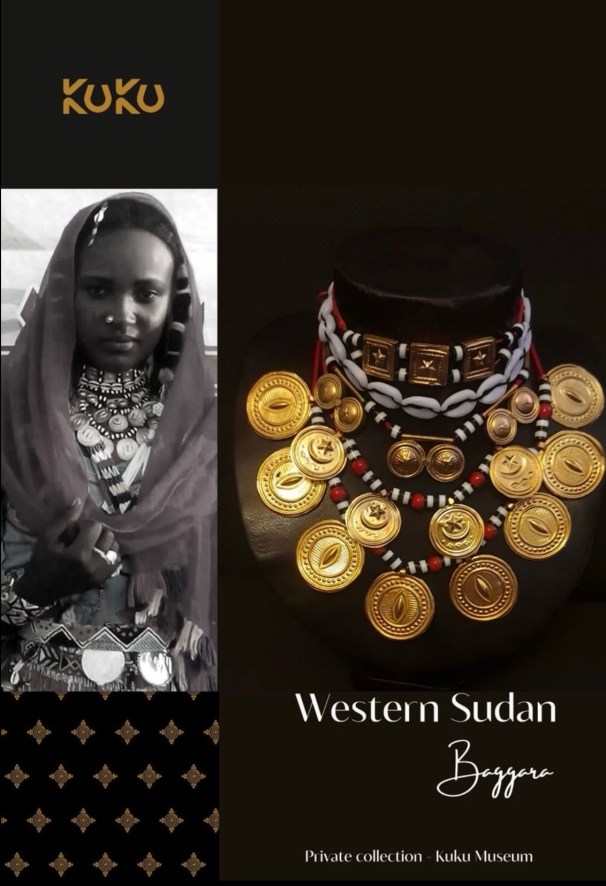
Cowries are still prized in contemporary Sudanese jewelry design, as in this stunning piece by Nisreen Kuku, drawing on the craft and esthetics of traditional western Sudanese jewelry.
More on Sudanese jewelry and adornment in “A Necklace of Shells from Distant Seas…”
Some believe the cowrie to have been brought to Africa by Arab traders from the Maldives in the 13th century, while others contend their presence was much earlier. Shells were used as currency in the Mali Empire of the 14th century, (The Shell Money of the Slave Trade, Jan Hogendorn and Marion Johnson). For many centuries cowries served as currency throughout Africa and Asia. Below, a colonial postcard depicting a small group of adults and children filling and emptying sacks of cowries, while others count the shells, (The British Museum, CC).

The cowrie as currency was to play a darker role in Arab, Ottoman and European slave trading across the Sahara. The massive importation of cowries by European powers in the 1800s was to destroy the currency as they capitalized on the brutality of the slave trade. We will see more on the link between cowries, slavery and Sudanese women’s spiritual rituals in Part 2. More on tracking the archeology of cowry commerce with special reference to Sudan in
This week’s article is the first of two on the symbolic and esthetic force of the cowrie in Sudan. Part 2 celebrates the use of cowries in jewelry, garments, camel and bull trappings and explores the fascinating role it plays in initiation, fertility and zār ceremonies throughout Sudan.

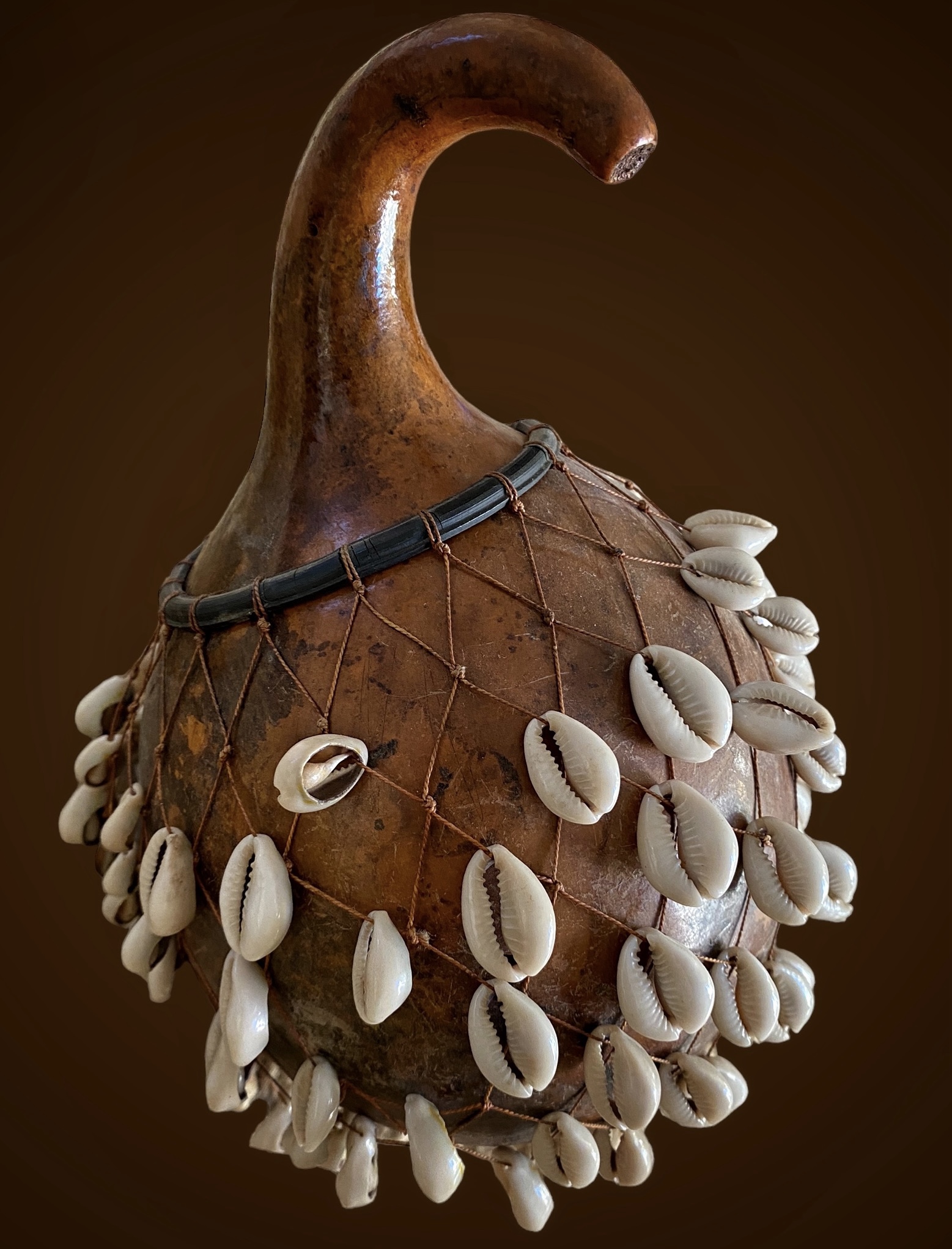


Above, examples of Sudanese craftsmanship featuring cowries; western Sudanese camel trappings and a cowrie-netted gourd rattle.

In an Uncertain World; Reading the Shells
falling like raindrops / the curved cowries / like a slanted lunar phase / three smile up at me as they land / but the last is buried down as the dead / /he loves me not
callie joseph, divining with cowries
Reading the Shells

Above, entry on “divination”, Sudan Arabic: An English -Arabic Vocabulary, 1925, Sudan Notes and Records, Sudan Open Archive. Reading of the shells is one of several Sudanese divination practice, detailed by Dr. Ahmed Al-Safi in Traditional Sudanese Medicine.
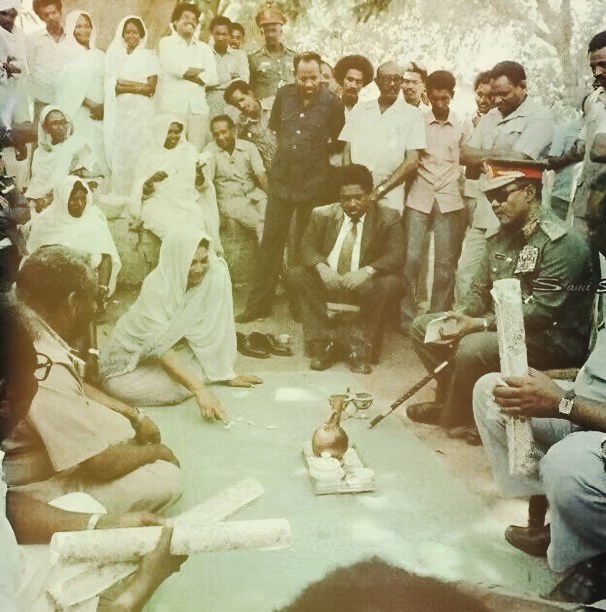
Writing on Rashaida women’s skills in negotiating the “daily unknowns so typical of life in rural Sudan”, (Taming Unknowns in Sudan), Sandra Calkins describes the strategies employed by Hamda, a young woman forced to ration her family’s meals in order to conserve her dwindling flour stocks.
Hamda draws instinctively on her firm Islamic faith, and the support of other women of her community, tackling her problems “actively, self-reliantly and pragmatically”. But she also consults “a fortune-teller, who lays out cowrie shells to predict when Hamda’s husband will send money from Kuwait or whether one of her sons-in-law will return with money from the gold mines – a practice that her brother-in-law, the sheikh and local imam condemns as spiritualistic and backward”.
Left, former president, Jaafer Numeiri is seen attending a sitting, Facebook, مقهى بوست.

Calkin’s research subjects were battling with seasonal food shortages and absent family wage-earners well over a decade ago yet the attitudes to cowrie reading she relates are still current today, against a backdrop of ever more unpredictable circumstances in a troubled land. Contemporary Sudanese and Middle Eastern journalists often voice the same disapproval as Hamda’s brother-in-law, describing the young women – and it is still predominantly the domain of women – who seek the services of the sitt al-wada’ as prey to “the grip of delusion” or worse, “falling into the web of shirk or polytheism”. Yet observers remain fascinated and curiously ambivalent as they cover the phenomenon and its therapeutic, consoling and folkloric influences, (sources listed at the end of this article).

Today, it seems this ancient custom has moved with the times, reaching new audiences and spreading beyond its traditional, intimate stronghold of women’s coffee gatherings in the home, venturing into more public spheres, with readers of the shells consulted by both men and women in precarious times. One correspondent noted that the sitt al-wada’ read her shells with the same nonchalance she would have her mobile phone and overheard, with some surprise, that she was being consulted on the ups and downs of stock market prices. While in the past a small symbolic sum or bayad was offered before the reading, to be augmented if the reading proved accurate, fees of up to fifty Sudanese pounds are being charged.
Once closely associated with rural village life, in the wake of mass migrations from the countryside, cowrie readings now enjoy popularity in the cities and, in particular, journalists note, in the upscale neighborhoods of the capital such as Al Amarat and Riyadh, where they appeal to the “wealthy and foreigners”, “lured into” consultations by the persuasive promise of personal insights.

Central, of course, to the status and credibility of the Sitt al-wada’ is a strong, mature personality, life experience, storytelling prowess and sense of humour. Researchers note she is embedded in the local community, enabling her to keep abreast of births, or lack of them, the marriage proposals that have prospered and all those that haven’t. A local figure of weight in her own right, an honoured guest and the recipient of valuable gifts, the sitt al-wada’ often enjoys a status akin to that of sheikha al-zār and indeed may claim the aid of invisible “servants” or compliant jinn in her sittings. Dr Al-Safi notes that while many women may claim “knowledge of interpretation”, “the most competent ‘sadiqa’ or expert readers are those who have learned its secrets in a dream, especially if that dream occurred in confinement.” He goes on to explain; “that is why seven shells are sometimes put under the pillow of a woman who has just delivered; at this time genuine knowledge about al-wad’a is believed to be revealed during dreams.” Traditional Sudanese Medicine.
The readings demand their own rituals; among them the offering of Sudanese coffee and the lighting of special incense. Any crackling of the burning nuggets of scented saps during a sitting is interpreted as an omen of grave import; the presence of envy or the evil eye. Certain days of the week are believed to be most propitious and as well as the symbolic pre-payment or bayad, gesture of the sitter’s trust, the client is expected to “state the object of the quest silently” (Al-Safi). More often than not, Al-Safi notes, clients sought the foretelling “of marriage and to whom, who is going to get what from whom, and who is going to arrive and when”. The readings were not used to diagnose disease but rather to follow its prognosis, Al-Safi found. Other have noted that the practice has evolved from foretelling fortunes to the curing of symptoms and illness.
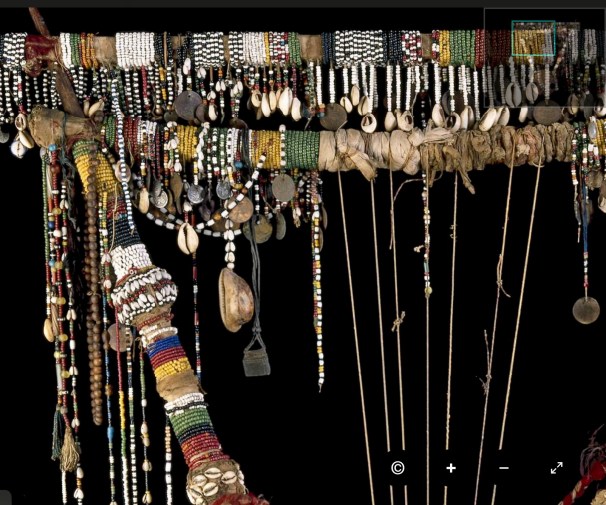
The cowrie-bedecked limbs of a Nubian lyre, an instrument often central to zār rituals. More on this in Part 2.
I close this article with a rough rendering of the spirit of the song, Sitt al Wada’; a song which encapsulates the wistful draw the reader of the cowries still exerts in Sudanese popular culture; a folkloric charm with a lexis all of its own.

In this famous ballad, the suitor begs the sitt al-wada’ to shake and throw the cowrie shells for him, with their distinctive jangling, rattling tone (kashkash), urging her not to hold back and to tell him the future however dark it might be. The sitt al-wada’ is disturbed by what she sees and sadly warns “Oh my child if only this fate were destined for your enemy and not you. What I see is grave and these two pale shells – pale because of their message – begin their whispering divination. The one you love has been betrothed to a man of high esteem. So, gather up your things (the gifts that form the bridal dowry or shayla provided by the groom) and save your dignity. Yet the sitt al-wada’ ends on a tender note; all is not lost perhaps, she hints. Their mutual love is not forgotten, although what fate has written on the forehead – the betrothal to another – cannot be erased.
See Part 2; Cowries as Adornment in Cowries in Sudan.
Selected Sources
African Cowrie Shells Divination
مي الودع طلاسم تسيير الحياة : وداعية: لم يعد الودع حكراً على النساء
انتشار ظاهرة ضرب الودع بصورة كبيرة فى السودان
بالصورة.. (ست الودع) السودانية تنجح في رفع أسعار الودع نظير معرفة ما سيحدث في المستقبل
“رمي الودع” في السودان محاولات اقتناص واقع مغاير
هل «رمي الودع» من الوقوع في شباك الشرك..!
يطرقن باب “ست الودّاع” ويلجن بيوت “دق الزار” حسناوات في قبضة الوهم


